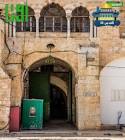|
باب العتم هو إحدى أبواب
المسجد الأقصى المفتوحة ويسمى أيضا باب فيصل نسبة إلى الملك
فيصل الأول. وقد جدد بناء هذا الباب في الفترة الأيوبية، في
أيام الملك المعظم ابن الملك العادل أبو بكر بن أيوب سنة 1213،
وذلك عند تجديد الرواق الشمالي للمسجد الأقصى. كما أنه يعرف
ولهذا الباب عدة أسماء فهو باب الدوددارية، وباب الملك فيصل،
وباب شرف الأنبياء.
وتتكون واجهة الباب الجنوبية من فتحة ارتفاعها 4 أمتار، وعليها
باب خشبي من دفتين يتقدمه من الجهة الجنوبية دركاة تعد جزءاً
من الرواق الشمالي، وهي مغطاة بعقد صليبي ومدخل الدركاة عبارة
عن قوس مدبب ضخم، وهو يقع ضمن سلسلة أقواس الرواق الشمالي
سمي بباب الملك فيصل منذ 1930م نسبة إلى الملك فيصل ملك
العراق؛ الذي دخل منه عندما زار المسجد الأقصى، فدعا المجلس
الإسلامي الأعلى الباب بهذا الاسم تخليداً لذكرى تبرعه لعمارة
المسجد الأقصى المبارك، وكان يعرف بالباب العتم لأن الزقاق
المؤدي له مسقوفة؛ وبباب الدوايدرية لقربه من مدرسة الدوايدرية
الملاصقة للسور الشمالي للمسجد الأقصى من الخارج؛ وبباب شرف
الأنبياء نسبة إلى الحارة التي يفضي إليها، وتم تجديد بنائه في
ولاية عز الدين بن يغمور في الفترة الأيوبية في عهد الملك
المعظم عيسى الأيوبي عام 610 هـ /1213م.
The darkness gate is one of the open gates of Al-Aqsa Masjed
northern part.
It is also called the Gate of Faisal in relation to King
Faisal the First. It was renovated in 610 AH/1213 AD, in the
Ayyubid period, during the reign of the great king, the son
of the just king, Abu Bakr bin Ayyub, when the northern
portico of Al-Aqsa Masjed was renovated. This gate is dubbed
also as the Gate of Faisal, the Duwaidaryah Gate and the
Gate of the Honor of the Prophets the Gate of the Honor of
the Prophets.
The southern façade of the gate consists of a 4 meters high
opening that contains a two shutters wooden door, preceded
by a vestibule on the southern side, which is part of the
northern aisle. It is preceded from the southern side by a
vestibule that is part of the northern aisle. It is covered
with a cruciform arch. The entrance to the vestibule is a
huge pointed arch. It is located within the chain of arches
of the northern aisle.
It has been called King Faisal Gate since 1930 AD, after
King Faisal of Iraq, who entered the Al-Aqsa Masjed during
his visit via this gate. Thus, the Supreme Islamic Council
called the gate by the king's name in memory of his donation
for the renovation of the blessed Al-Aqsa Masjed. The gate
also known as the Gate of Darkness because the alley leading
to it is roofed; and the Duwaidaryah Gate since of its
proximity to Al-Duwaidaryah School, adjacent to the northern
wall of Al-Aqsa Masjed from the outside; and the Gate of the
Honor of the Prophets, after the Honor of the Prophets
Quarter to which the gate leads. It was restored during
reign of Izz al-Din ibn Yaghmour in the Ayyubid period
during the reign of the great King Isa al-Ayyubi in 610 AH /
1213 AD.
Item Kapısı, Mescid-i Aksânın açık
kapılarından biridir. Kral 1. Faysala istinaden Faysal
Kapısı olarak da isimlendirilir. Eyyubîler zamanında
Melikül-Muazzam bin Melik Adil Ebu Bekir bin Eyyub
döneminde Miladi 1213, Hicri 610 senesinde Mescid-i Aksânın
kuzey revakları yenilenirken bu kapı da yenilenmiştir. Bu
kapı ayrıca Devadariyye Kapısı, Melik Faysal Kapısı ve
Şerefül-Enbiya Kapısı isimleriyle de bilinir.
Kapının güney cephesi 4 metrelik bir
açıklıktan oluşmaktadır ve güneyinde direkt kuzey
revaklarından sayılan bir kısmın öncelediği iki sütunlu
ahşap bir kapısı vardır. Bu kısmın girişi, kuzey
revaklarının kemer zincirinde yer alan devasa sivri bir
kemerden oluşmaktadır.
Irak kralı 1. Faysalın Mescid-i Aksâyı ziyaret ettiğinde
girdiği kapı olmasına istinaden 1930 yılından itibaren Kral
Faysal Kapısı olarak isimlendirilmiştir. Yüksek İslam
Şûrası, mübarek Mescid-i Aksânın imarına yaptığı bağışların
anısını ebedileştirmek için kapıya onun ismini vermiştir.
Item (Karanlık) Kapı olarak bilinmesi ona açılan ara
sokağın çatılı olması sebebiyle karanlık olduğundandır.
Devadariyye denmesi ise dış kısımdan Mescid-i Aksânın kuzey
suruna bitişik olan (Alemüd-Din Emir Sencer Devadarın
yaptırıp vakfettiği) Devadariyye medresesine yakınlığı
sebebiyledir. Kapının açıldığı mahallenin ismine nisbetle de
Şerefül-Enbiya olarak bilinmektedir. Yenilenmesi, Eyyübîler
zamanında Melikül-Muazzam İsa El-Eyyübî döneminde İzzeddin
bin Yağmur valiliğinde Miladi 1213, Hicri 610 tarihinde
tamamlandı. |
